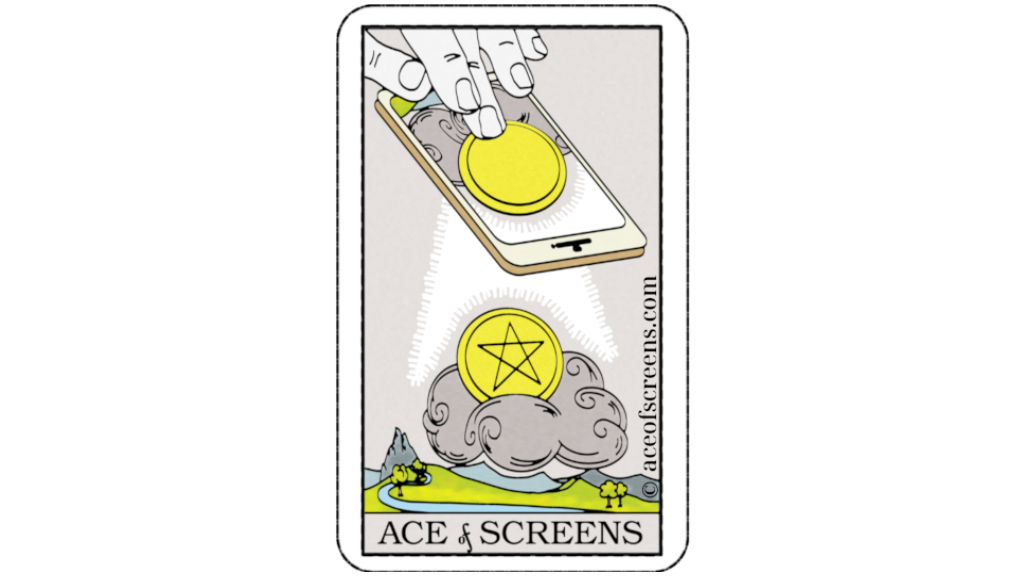
— Technical Documentation —

In this boundless universe, we are not born with a compass or a map. We navigate through the unknown by forging our own paths and creating maps as we go. Only when we look back can we see if the map led us to our destination.
The original roots of Tarot do not lie in fortune-telling. Fortune-telling was later invented as a secondary purpose and is nothing more than a modern pseudoscience.
Originally, Tarot cards served as a tool for self-reflection and the exploration of the unknown. Their symbolic representations offer guidance to the unexperienced mind and provide insights into spiritual themes that remain unexplored. As a reference book, they inspire individuals to embark on their own experiences, for without experience, there can be no true wisdom. The cards are simply a collection of symbols designed to inspire the attentive and curious mind to elevate itself to a higher level of awareness through the careful exploration of new experiences over the course of life.
Tarot has its roots in the Egyptian Book of Thoth. Its ideas were adopted by cultures such as Jewish Kabbalah, the Asian I-Ching, and the Hindu chakra system. It is a universal symbolic language that reveals pathways to the development of consciousness—pathways that each person can only walk through their own experiences.
The Tarot is a collection of pointers, trying to guide us with their symbolism towards a meaningful approach to the unknown. However, the cards can only point out directions. It is up to us to decide which paths we explore and understand.
The consciousness of every human being, during its lifetime, goes through a transformation in that by gaining holistic experiences, the connection between the outer cosmos through the body with the inner cosmos of consciousness is completed.
To achieve this, the consciousness must navigate into the unknown. There the physical presence fully inhabits the moment of experience, allowing for a previously unknown connection to be made.
The 4 Aces in Tarot symbolize a call to explore the unknown with the aid of the 4 magical tools: sword, chalice, wand and disc.
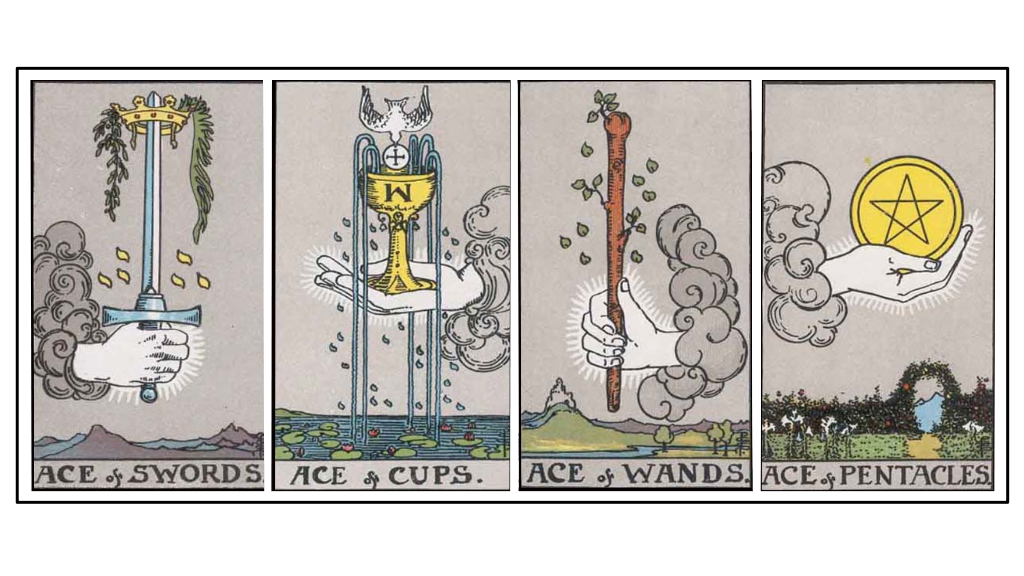
The unknown is represented by the cloud. The cloud can be seen externally, but one cannot look into the cloud. The hand symbolizes experience in a moment of presence and extends a magical tool to us for grasping.
Through the conscious use of the tool, a holistic connection between the external cosmos through the body with the inner cosmos is completed. Thus, the hand first enters the cloud, before it is later only perceived in consciousness what is happening within it.
The Unknown has four elementary dimensions that are revealed by the four magical tools, sword, chalice, staff, and coin. These four magical tools symbolize the four fundamental cosmic elements of spirituality: air, water, fire, and earth.
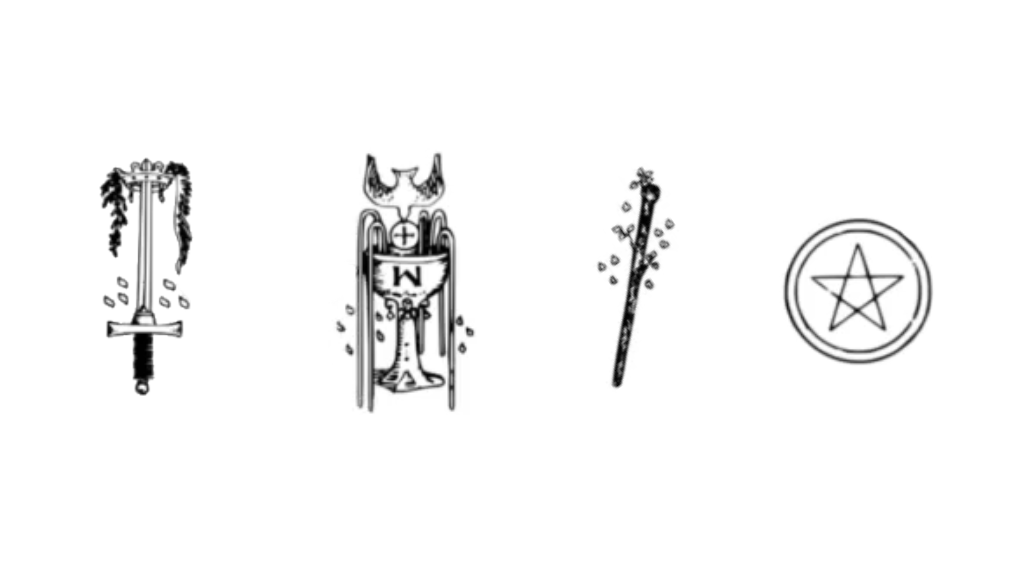
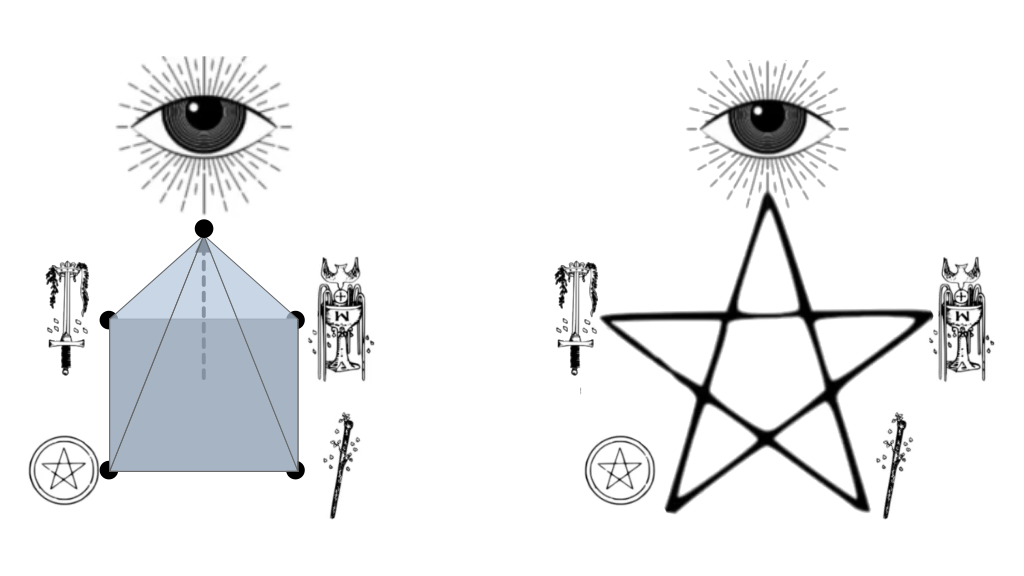
By comprehensively exploring the unknown with the aid of the four magical tools, the spirit achieves magical sight and rises. This is represented by the 5-pointed star, which connects the four dimensions of the unknown, giving rise to magical sight. The uplifted spirit is capable of especially profound conscious connection with the processes of the universe.
Just like Tarot cards themselves, any representations of information as image, sound, or script are subject to the same limitation: no matter how realistic or complete a representation may appear, it can never completely replace the all-encompassing moment of physical presence. A representation is and remains a material image, designed in such a way that it appears all-encompassing but cannot ever fully replace presence.
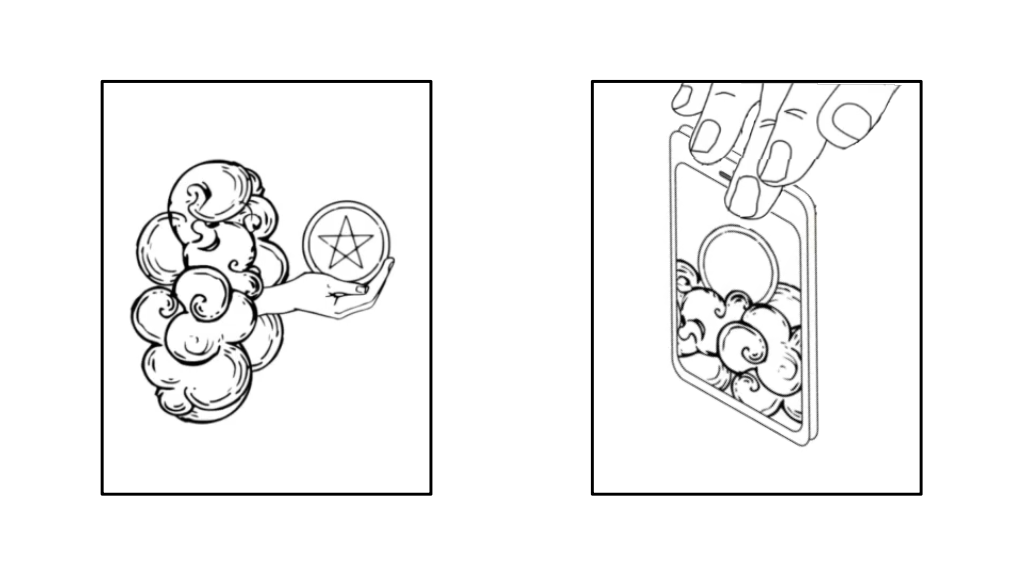
For decades now, new technological representations such as screens have made possible the constant presence of ultra-high resolution audio- and photo-realistic information, which can be reproduced without limitation at any time. Regardless of how much detail these machines exceed, these representations also follow the law that they serve only as a guide for the acquisition of holistic experiences through one’s own body alone.
No matter how real an experience is represented on a screen using image and sound. It remains a representation and can never fully replace the actual presence of what is portrayed. The connection between the outer cosmos through the body with the inner cosmos of consciousness can only occur through physical presence in the all-encompassing moment. There, all senses are affected by magical sight, not just image and sound.
Ace of Screens is the 5th Ace in the Tarot, newly created through a rearrangement of the symbolism of the existing Aces in the Tarot.
In the original Ace, the hand extends the tool towards the cloud, calling on the unknown to be discovered independently. By grabbing and applying the tool, the cloud is traversed, a part of the unknown is ventilated, and it becomes visible for the consciousness. The coin was chosen because in the Tarot it symbolizes a deep physical and conscious connection to the Universe, embodying the process of raising magical vision through the Star itself.
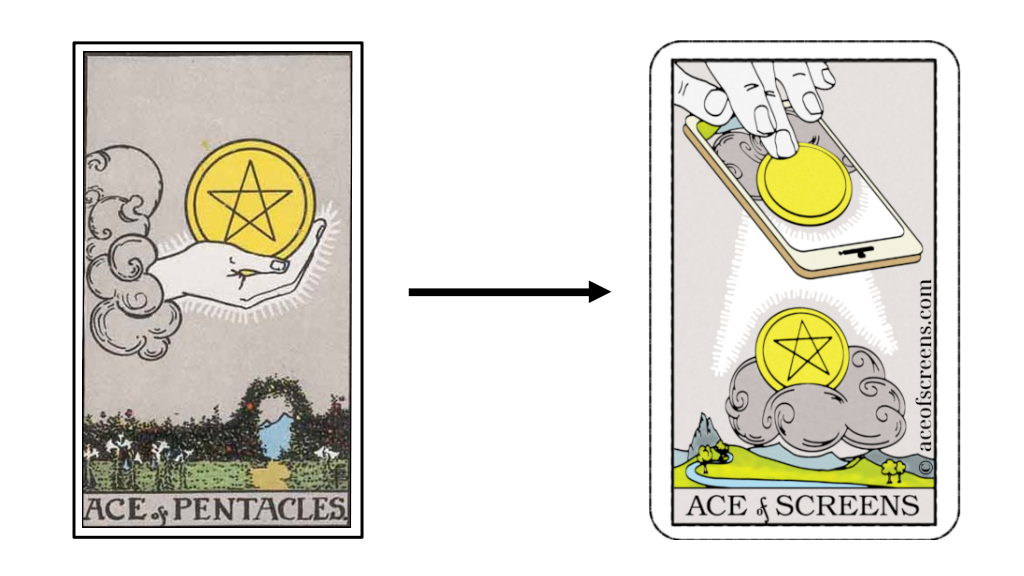
In Ace of Screens, the hand, cloud, and coin are rearranged, and a material representation is added. The material representation separates the magical tool and the cloud from experience, as the hand now touches the display - not the tool. However, the Star is not depicted on the screen since the image cannot capture all senses and thus never replace a full-bodied experience through one’s own body. Just like the Tarot card itself, the image can only serve as a guide to a complete bodily experience.
The Tarot readers draw our attention to the unknown and direct experiences with the 4 cosmic elements, to navigate them. On the other hand, the Ace of Screens describes the »anti-element«, an experience with a material representation that can be broadcast, for example, through audiovisual signals on a screen. The material representation can only incompletely convey direct experience of the depicted object, but with high precision and technical exactness it can create an illusion of completeness. Due to the fact that the material representation cannot fully convey direct experience, our subconscious mind performs a mental simulation that contains all aspects of the complete moment which our senses do not grasp from the material representation.
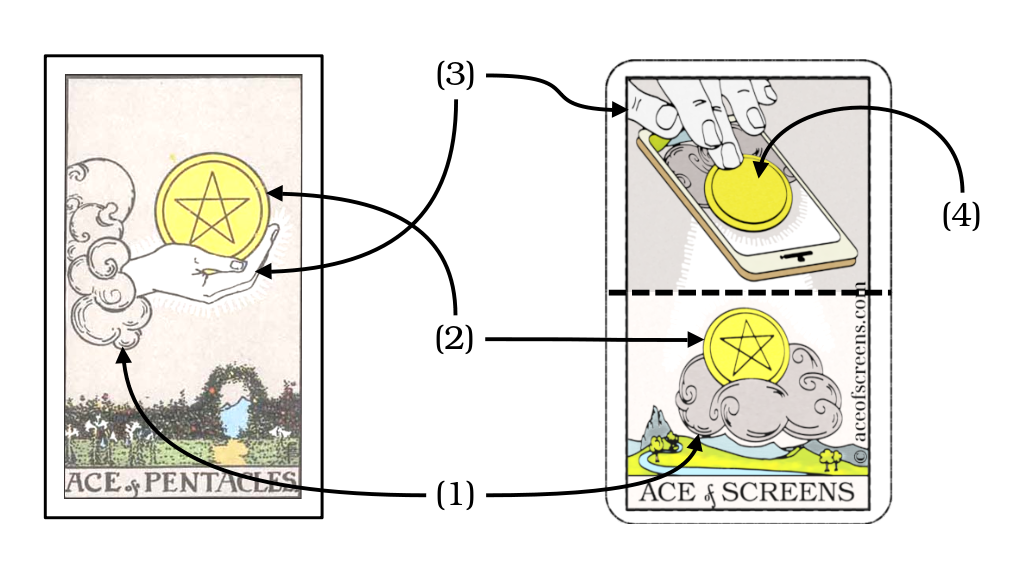
In the Ace of Screens, this is depicted through the separation of (1) the unknown and (2) the magical tool from (3) the experience through (4) the material representation. When an simulated experience is derived from the material representation, a problem arises in an esoteric way.
Since the human mind creates all mental images or simulated experiences from memories that have been gained through bodily experiences in life, this limitation hinders the research of the unknown using only mental simulation, as one can only mentally simulate what has previously been experienced physically. The simulated experience that seems to exceed the boundaries of the unknown remains a mystery until the experience itself is marked by the presence in the all-encompassing moment.
Therefore, for the one who does not aware of the limitations of representational images, there is a risk of confusion between: »something experienced physically in the all-encompassing moment« and »something simulated mentally on a screen through visual and audio representations«. There is the risk that the unknown, as it has not yet been seen, may be mistakenly assigned.
The Ace of Screens symbolises 4 possible states, which concern the presence of extended awareness about the depiction and direct experience with the depicted.
Extended awareness (X) over the depiction refers to the knowledge that any presentations of information with images, sound, text or screens are subject to limitations, never being able to fully replace the moment of physical presence.
Direct experience (Y) with the depicted refers to the circumstance, whether the “depicted in material form” has already been experienced physically in the past moment of all-encompassing bodily presence.
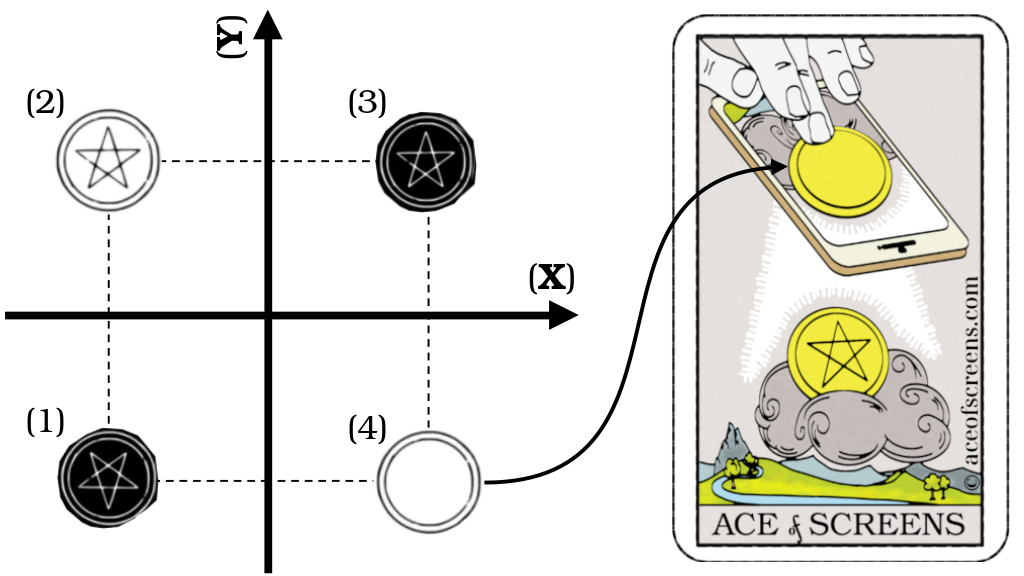
State (1)
The consciousness of mental simulation is not present. The depicted scenario has never been directly experienced. The mental simulation that apparently transcends the boundary of the unknown may be mistakenly identified with a physically all-encompassing moment lived and the unknown may incorrectly be attributed to it.
State (2)
There is no awareness of the executed mental simulation. The experience with what was shown is present and has been imprinted in consciousness at the moment of all-encompassing physical presence. The mental simulation in the subconsciousness does not exceed the boundary into the unknown. The image activates memories of the physically experienced moment.
State (3)
The consciousness of mental simulation is developed. The experience with what is being displayed is present and was already impressed in the mind during the all-encompassing physical presence. The image serves as a reminder of this moment and activates the body accordingly through mental simulation.
State (4)
The consciousness of mental simulation is developed. At the same time, one is aware that what is presented has never been directly experienced. The mental simulation, which seems to cross the boundary of the unknown, remains a mystery. The image can be used as a guide to experience a moment all-encompassingly physically.